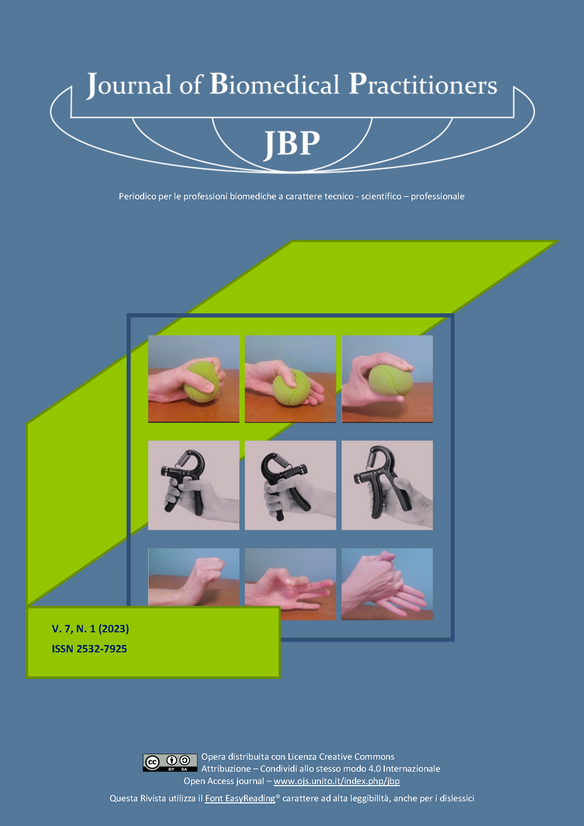Occupational Therapy strategies and environmental adaptation, using a client-centered practice, in Idiopathic Inflammatory Myopathies: a case report
Main Article Content
Abstract
INTRODUCTION
Idiopathic Inflammatory Myopathies are rare conditions; therefore, we are not aware of possible results in the scientific literature concerning the treatment of Occupational Therapy in this specific field. Treatment is currently based on drug therapy in combination with exercise and rehabilitation. The purpose of this article is to present a clinical case of a young woman and the related occupational therapy intervention useful for achieving independence and improving her quality of life.
CASE PRESENTATION
The case report of the study concerns a young 15-year-old woman with weakness in the upper limbs and difficulties in the fine distal hand movements such as affecting various activities of daily life. The Occupational Therapy intervention envisaged a "client-centered" practice. In fact, the objectives were identified together with the patient, based on her needs, values, preferences and expectations.
The Canadian Measure of Occupational Performance (COPM) was used to identify the objectives of the rehabilitation project. The Independence Assessment Scale (FIM) was used to further support the COPM score. Using an analogue scale on fatigue, the young woman then self-assessed the level of perceived fatigue for each activity performed. After identifying the major problems, aids were proposed, strategies useful for acquiring new skills, but also adaptive strategies and modifications of the physical and social environment.
RESULTS
After the Occupational Therapy intervention, the average satisfaction and performance scores, measured using the COPM, showed a positive variation of 175% and 144% respectively; the FIM score increased by 28%; instead, the average perceived fatigue score denoted a 43% reduction. The patient has thus achieved an improvement in performance and, therefore, full autonomy in various activities of daily life identified by her.
DISCUSSIONS
This clinical case indicates that the treatment of Occupational Therapy, centered on the patient, based on the identification of the right strategies, aids and environmental modifications and adaptations can be effective in improving the quality of life of the person with a rare condition such as myositis.
CONCLUSIONS
Despite the results achieved, it is necessary to continue to deepen the studies, to disseminate material on the subject and the experiences of other occupational therapists, to expand the scientific panorama to obtain more evaluation tools, and to draw up the official guidelines for the treatment of therapy employment in juvenile myositis.
Downloads
Article Details
The authors agree to transfer the right of their publication to the Journal, simultaneously licensed under a Creative Commons License - Attribution that allows others to share the work indicating intellectual authorship and the first publication in this magazine.
References
[2] Acosta, Ignacio, Matamala, José Manuel, Jara, Paula, Pino, Francisca, Gallardo, Alejandra, & Verdugo, Renato. (2019). Miopatías inflamatorias idiopáticas: una mirada actualizada al diagnóstico y el manejo. Revista médica de Chile, 147(3), 342-355. https://dx.doi.org/10.4067/S0034-98872019000300342
[3] Dimachkie MM, Barohn RJ, Amato AA. Idiopathic inflammatory myopathies. Neurol Clin. 2014 Aug;32(3):595-628, vii. doi: 10.1016/j.ncl.2014.04.007. PMID: 25037081; PMCID: PMC4104537.
[4] Dalakas MC. Inflammatory muscle diseases. N Engl J Med 2015; 372: 1734–1747. doi:10.1056/NEJMra1402225
[5] Miller FW, Lamb JA, Schmidt J, Nagaraju K. Risk factors and disease mechanisms in myositis. Nat Rev Rheumatol. 2018 Apr 20;14(5):255-268. doi: 10.1038/nrrheum.2018.48. PMID: 29674613; PMCID: PMC6745704.
[6] Tomaras, S., Kekow, J., & Feist, E. (2020). Idiopathische inflammatorische Myopathien [Idiopathic Inflammatory Myopathies]. Deutsche medizinische Wochenschrift (1946), 145(13), 903–910. https://doi.org/10.1055/a-1018-3008
[7] Meyer A, Meyer N, Schaeffer M et al. Incidence and prevalence of inflammatory myopathies: a systematic review. Rheumatology (Oxford) 2015; 54: 50–63. doi:10.1093/rheumatology/keu289
[8] Cunningham Piergrossi J.: Essere nel fare. Introduzione alla Terapia Occupazionale, Franco Angeli, 2006.
[9] Law M, Baptiste S, McColl M, Opzoomer A, Polatajko H, Pollock N. The Canadian occupational performance meas-ure: an outcome measure for occupational therapy. Can J Occup Ther. 1990 Apr;57(2):82-7. doi: 10.1177/000841749005700207. PMID: 10104738.
[10] Willard H., Spackman C.: Terapia Occupazionale, Antonio Delfino Editore. 2008.
[11] Law M, Baptiste S, McColl M, Opzoomer A, Polatajko H, Pollock N. The Canadian occupational performance meas-ure: an outcome measure for occupational therapy. Can J Occup Ther. 1990 Apr;57(2):82-7. doi: 10.1177/000841749005700207. PMID: 10104738.
[12] Compston A. (2010). Aids to the investigation of peripheral nerve injuries. Medical Research Council: Nerve In-juries Research Committee. His Majesty's Stationery Office: 1942; pp. 48 (iii) and 74 figures and 7 diagrams; with aids to the examination of the peripheral nervous system. By Michael O'Brien for the Guarantors of Brain. Saunders Elsevier: 2010; pp. [8] 64 and 94 Figures. Brain: a journal of neurology, 133(10), 2838–2844. https://doi.org/10.1093/brain/awq270
[13] Dreiling, D. (2009). Energy Conservation. Home Health Care Management & Practice, 22(1), 26–33. https://doi.org/10.1177/1084822309340301.
[14] Del Rosso Angela, Maddali Bongi Susanna (2015). “Il trattamento riabilitativo delle connettiviti. Evidenze scien-tifiche”, in Maddali Bongi Susanna (édité par), La riabilitazione multidisciplinare del malato reumatico, Maddali e Bruni, Firenze, p. 258-267, ISBN: 978-88-909891-9-3.
[15] Caracciolo A., Redaelli T.: Tearapia occupazionale: ausili e metodologie per l’autonomia, Raffaello Cortina Edito-re, 2008.
[16] American Occupational Therapy Association. (2020). Occupational therapy practice framework: Domain and pro-cess (4th ed.). American Journal of Occupational Therapy, 74(Suppl. 2), Article 7412410010.
[17] Mu, K., & Royeen, C. (2004). Facilitating participation of students with severe disabilities: Aligning school-based occupational therapy practice with best practices in severe disabilities. Physical & Occupational Therapy in Pe-diatrics, 24(3), 5-21.
[18] Deshaies LD, Yasuda YL, Beardmore T. Occupational therapy management of a patient with severe polymyositis. Arthritis Care Res. 1994 Jun;7(2):104-7. doi: 10.1002/art.1790070210. PMID: 7857992.
[19] Lovell DJ, Lindsley CB, Rennebohm RM, Ballinger SH, Bowyer SL, Giannini EH, Hicks JE, Levinson JE, Mier R, Pachman LM, Passo MH, Perez MD, Reed AM, Schikler KN, Smith M, Zemel LS, Rider LG. Development of validated disease activity and damage indices for the juvenile idiopathic inflammatory myopathies. II. The Childhood Myo-sitis Assessment Scale (CMAS): a quantitative tool for the evaluation of muscle function. The Juvenile Derma-tomyositis Disease Activity Collaborative Study Group. Arthritis Rheum. 1999 Oct;42(10):2213-9. doi: 10.1002/1529-0131(199910)42:10<2213::AID-ANR25>3.0.CO;2-8. PMID: 10524696.
[20] Pilkington, C. A., & Wedderburn, L. R. (2005). Paediatric idiopathic inflammatory muscle disease: recognition and management. Drugs, 65(10), 1355–1365. https://doi.org/10.2165/00003495-200565100-00004.

